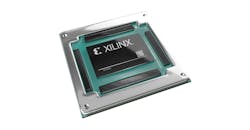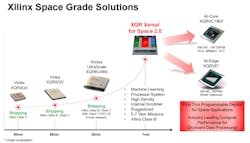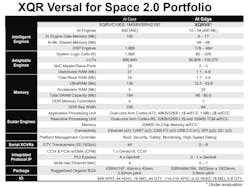Xilinx Rolls Out Rugged Versal Families for Aerospace and Defense
Xilinx is doubling down on the aerospace and defense sector with two new lines of programmable chips: the space-grade XQR Versal and the military-grade XQ Versal families.
The ruggedized devices are based on the 7-nm node, promising a major leap in computational performance and improvements in size, weight, and power efficiency (SWaP) over Xilinx's previous generation of space- and defense-grade chips. Xilinx said the XQR and XQ families are based on its adaptable compute acceleration platform (ACAP), called Versal, which also is targeted at cloud data centers and telecom gear.
Xilinx’s Versal family combines scalar engines (Arm CPU cores), intelligent engines (AI and DSP accelerators), and the same type of programmable logic at the heart of its field-programmable gate arrays (FPGAs). These building blocks share the same system-on-a-chip (SoC) with hard-cores for connectivity and security. One of the major differences with Xilinx’s Zynq UltraScale MPSoC line, which also contains Arm CPUs paired with hard-core peripherals, is a network-on-a-chip (NoC) that ties everything together on the Versal chips.
XQR Versal ACAP
Xilinx is trying to cement its status as a major player in the growing satellite market with its new Versal XQR chips, available in both “AI core” and “AI edge” configurations. The adaptable processors, which have radiation tolerance to protect against catastrophic failures, are designed to bring new levels of onboard data processing and on-device artificial intelligence (AI), such as image classification and object detection, to satellites.
With the new chips, Xilinx is trying to take advantage of the growing market for satellites, which must be as light, energy-efficient, and compact as possible to reduce costs. SpaceX is rolling out thousands of satellites—what the space industry calls a "constellation"—designed to beam high-speed broadband internet to people on earth. Many others, including startups, are placing networks of satellites in orbit that can capture images of the earth—from international shipping lanes to store parking lots—and use machine learning to gain insights.
Xilinx said the more advanced “AI core” product in the Versal XQR portfolio is due out by the second half of 2022. The "AI edge" series of products will not start shipping until the second quarter of 2024, Xilinx said.
The chips can process hundreds of gigabits per second of data on-device instead of offloading it to ground stations. They also have reduced latency and high bandwidth for broadband communications, Xilinx said.
The reconfigurable nature of the space-grade XQR family of chips means that it can also be reprogrammed to suit specific use cases, such as monitoring weather patterns or tracking deforestation, while in orbit. The XQR chips are following the release last year of what Xilinx called its first 20-nm space FPGA for satellite and other in-orbit electronics, which is also designed to bring more machine learning muscle to satellites.
When heavy doses of radiation in space strike silicon, they can create electrical charges that interfere with their operation or destroy unprotected hardware. These types of chips also need durability against vibrations and other stresses during launch. And without the protection of the earth's atmosphere, electronic devices flying in orbit are vulnerable to a bombardment of radiation and wild swings in temperature.
The space-grade AI core chips, which are designed for missions lasting up to seven years, come in an organic ball-grid array (BGA) package that measures 45- x 45-mm and has a “stiffener ring” to dissipate larger amounts of heat from the chip. In addition, the rugged packaging can handle the harshness of space, supporting the Mil-Std-883 Class B-grade standard and radiation tolerance in both low-earth (LEO) and geosynchronous orbits.
The chip integrates dual Arm Cortex-A72 CPUs with 48 KB instruction cache, 32 KB of data cache, and 1 MB of L2 cache. The real-time processing engine features a dual-core Arm Cortex-R5 with 64 KB of L1 cache, divided evenly between instructions and data, as well as 256 KB of tightly coupled memory (TCM). The caches inside the chip are all based on error correction code (ECC) memory.
The new chip incorporates interfaces such as 8x lanes of PCI Express (PCIe) Gen 4 and 16x lanes of CCIX for accelerators. It also features high-speed I/O for sensors and a memory interface that supports DDR4 DRAM.
XQ Versal ACAP
Xilinx is also upgrading its chips for the aerospace and defense industry that it has served for more than 30 years. The Santa Clara, California-based company said the 7-nm Versal XQ family is the world’s most advanced processor for aerospace and defense. Along with handling harsh conditions on battlefields, the heterogeneous multicore processors can carry out AI chores and be reconfigured to adapt to evolving algorithms.
The chips contain Arm’s Cortex-A72 and Cortex-R5 real-time CPUs, supplemented by a hefty amount of on-chip memory. Customers can use the programmable logic inside to run sensor fusion, radar or image processing, or other workloads. These engines communicate with the AI and DSP blocks over the network-on-chip (NOC). The military-grade product line also supports PCIe and CCIX as well as high-bandwidth memory (HBM).
The chips in the XQ family feature ruggedized packaging rated to the Mil-Std-883 standard, with the ability to withstand moisture, dirt, shocks, vibration, radiation, and temperatures ranging from -55°C to 125°C.
The BGA package is based on tin and lead, and the company said it has mitigated the problem of “tin whiskering," where conductive threads of tin grow out of the packages finished with the metal. Short circuits caused by whiskering can lead to system failures that can be perilous in combat situations.
The family spans “edge,” “AI core,” “prime,” and “premium” configurations, each presumably with more compute density and higher bandwidth than the last. Xilinx said the chips should be available in the first quarter of 2022.
AMD has agreed to buy Xilinx for approximately $35 billion. The deal is expected to close by the end of 2021.
About the Author
James Morra
Senior Editor
James Morra is the senior editor for Electronic Design, covering the semiconductor industry and new technology trends, with a focus on power electronics and power management. He also reports on the business behind electrical engineering, including the electronics supply chain. He joined Electronic Design in 2015 and is based in Chicago, Illinois.





